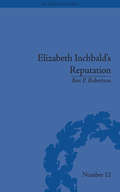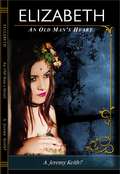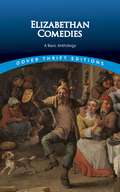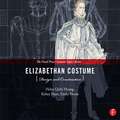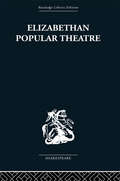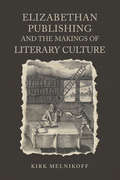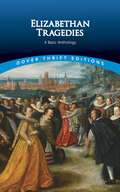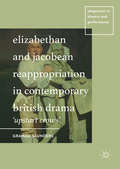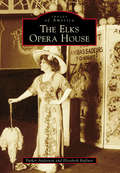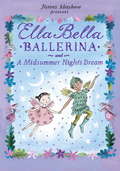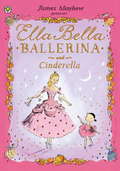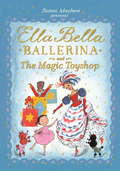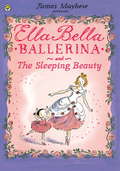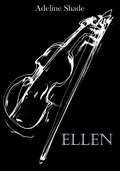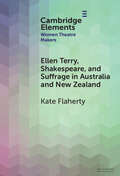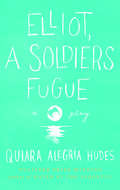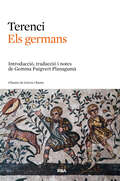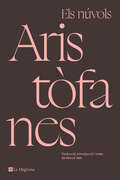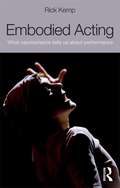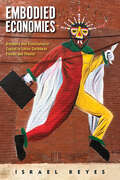- Table View
- List View
Elizabeth Inchbald's Reputation: A Publishing and Reception History (The History of the Book #12)
by Ben P RobertsonThrough an examination of her complete works and public response to them, Robertson gauges the extent of Inchbald's reputation as the dignified Mrs Inchbald, as well as providing a clear sense of what it meant to be a female Romantic writer.
Elizabeth: An Old Man's Heart
by A. Jeremy KeithElizabeth: An Old Man’s Heart is a novel of intrigue and romance. It’s the type of novel that we can identify with. It transcends the story told by an old man to a detective, in which he says goodbye to adolescence, and of course, to the myth that symbolized the love he found in his youth. It was a time when reason became a puppet of destiny, induced by emotion. The story revolves around Richard Keith, Elizabeth, and Alejandra. Richard, the main character in this story, falls in love with Elizabeth, whose beauty leaves him speechless and turns his heart into a runaway locomotive. Because that’s what happens when we fall in love: we feel like our world turns topsy-turvy. Elizabeth is the pinnacle of beauty for Richard Keith. He started to love her as a boy and always noticed her during recess. One day he gathered up his courage and wrote his first letter to her. Elizabeth, innocent in her thoughts, didn’t know what love was and she tore up the letter. Even so, the brave boy insisted until the day when she didn’t tear his letters up. However, she never replied. One day, he grew tired and stopped sending them. After a year, Elizabeth started to miss the beautiful words that Richard Keith wrote to her. In junior high Elizabeth loved him, but he wasn’t as brave as he had been as a child, though his love hadn’t changed. His self-esteem had taken a severe blow when he lost strength in his legs and started walking with a pronounced limp. Find out what happens between Richard Keith and Elizabeth, and what role Alejandra plays in their lives. What will happen when he wants to fix the past? Who will die, and who will live to tell about it? Poetic thoughts aren’t born with us, they’re provoked by destiny, which at the same time plays with our minds. The game of love is a passion that drives us crazy and hypnotizes the soul. Destiny seeks its own muse to go crazy and grow old with, but at the same time, it gives us the opportunity to know and ex
Elizabethan Comedies: A Basic Anthology (Dover Thrift Editions)
by Inc. Dover PublicationsA new and vital form of drama blossomed in 16th-century England, blending classic Latin comedy traditions with keen satires of contemporary London life. Although Shakespeare remains the most recognizable playwright of the Elizabethan age, there were many others whose work continues to entertain and educate students of drama to this day. This anthology collects timeless comedies that both informed Shakespeare's work and took inspiration from the Bard himself.Six plays include Ben Jonson's Every Man in His Humour, the comedy that made the author's reputation; Friar Bacon and Friar Bungay by Robert Greene, a groundbreaking play in terms of multiple-plot structure; The Shoemaker's Holiday, or The Gentle Craft by Thomas Dekker, the "Dickens of English theater"; All Fools, George Chapman's sprightly romp; A Trick to Catch the Old One by Thomas Middleton, one of the era's most prolific and successful playwrights; and Eastward Ho!, a collaborative work by Chapman, Jonson, and John Marston.
Elizabethan Costume Design and Construction: (The Focal Press Costume Topics Series) (The Focal Press Costume Topics Series)
by Helen Q Huang Emily Hoem Kelsey HuntLearn how to create historically accurate costumes for Elizabethan period productions with Elizabethan Costume Design and Construction! Extensive coverage of a variety of costumes for both men and women of all social classes will allow you to be prepared for any costuming need, and step-by-step instructions will ensure you have the know-how to design and construct your garments. Get inspired by stunning, hand-drawn renderings of costumes used in real life productions like Mary Stuart as you’re led through the design process. Detailed instructions will allow you to bring your designs to life and create a meticulously constructed costume.
Elizabethan Grotesque (Routledge Revivals)
by Neil RhodesThe comic grotesque is a powerful element in a great deal of Elizabethan literature, but one which has attracted scant critical attention. In this study, first published in 1980, Neil Rhodes examines the nature of the grotesque in late sixteenth-century culture, and shows the part it played in the development of new styles of comic prose and drama in Elizabethan England. In defining ‘grotesque’, the author considers the stylistic techniques of Rabelais and Aretino, as well as the graphic arts. He discusses the use of the grotesque in Elizabethan pamphlet literature and the early satirical journalists such as Nashe, and argues that their work in turn stimulated the growth of satirical drama at the end of the century. The second part of the book explains the importance of Nashe’s achievement for Shakespeare and Jonson, concluding that the linguistic resources of English Renaissance comedy are peculiarly – and perhaps uniquely – physical.
Elizabethan Popular Theatre: Plays in Performance
by Michael HattawayElizabethan Popular Theatre surveys the Golden Age of English popular theatre: the 1590s, the age of Marlowe and the young Shakespeare. The book describes the staging practices, performance conditions and acting techniques of the period, focusing on five popular dramas: The Spanish Tragedy, Mucedorus, Edward II, Doctor Faustus and Titus Andronicus, as well as providing a comprehensive history of a variety of contemporary playhouse stages, performances, and players.
Elizabethan Publishing and the Makings of Literary Culture (Studies in Book and Print Culture)
by Kirk MelnikoffElizabethan Publishing and the Makings of Literary Culture explores the influence of the book trade over English literary culture in the decades following incorporation of the Stationers’ Company in 1557. Through an analysis of the often overlooked contributions of bookmen like Thomas Hacket, Richard Smith, and Paul Linley, Kirk Melnikoff tracks the crucial role that bookselling publishers played in transmitting literary texts into print as well as energizing and shaping a new sphere of vernacular literary activity. The volume provides an overview of the full range of practises that publishers performed, including the acquisition of copy and titles, compiling, alteration to texts, reissuing, and specialization. Four case studies together consider links between translation and the travel narrative; bookselling and authorship; re-issuing and the Ovidian narrative poem; and specialization and professional drama. Works considered include Shakespeare’s Hamlet, Thévet’s The New Found World, Constable’s Diana, and Marlowe’s Dido, Queen of Carthage. This exciting new book provides both a complement and a counter to recent studies that have turned back to authors and out to buyers and printing houses as makers of vernacular literary culture in the second half of the sixteenth century.
Elizabethan Tragedies: A Basic Anthology
by Inc. Dover PublicationsAlthough Shakespeare towers over the Elizabethan period, it was a robust time in the evolution of English theater, and many plays beyond the Bard's survive to enthrall modern drama students. This original anthology collects prime examples of the era's tragedies, dramas that both informed and were influenced by Shakespeare's work.Include here are The Spanish Tragedy, by Thomas Kyd; Doctor Faustus, by Christopher Marlowe; Thomas Heywood's A Woman Killed with Kindness; The Tragedy of Mariam, by Elizabeth Cary (the first work in English to be published under a female author's own name); and John Webster's The Duchess of Malfi.
Elizabethan and Jacobean Reappropriation in Contemporary British Drama
by Graham SaundersThis book examines British playwrights' responses to the work of Shakespeare and his contemporaries since 1945, from Tom Stoppard's Rosencrantz and Guildenstern are Dead to Sarah Kane's Blasted and Jez Butterworth's Jerusalem. Using the work of Julie Sanders and others working in the fields of Adaptation Studies and intertextual criticism, it argues that this relatively neglected area of drama, widely considered to be adaptation, should instead be considered as appropriation - as work that often mounts challenges to the ideologies and orthodoxies within Elizabethan and Jacobean drama, and questions the legitimacy and cultural authority of Shakespeare's legacy. The book discusses the work of Howard Barker, Peter Barnes, Edward Bond, Howard Brenton, David Edgar, Elaine Feinstein and the Women's Theatre Group, David Greig, Sarah Kane, Dennis Kelly, Bernard Kopps, Charles Marowitz, Julia Pascal and Arnold Wesker.
Elks Opera House, The (Images of America)
by Parker Anderson Elisabeth RuffnerFor over 100 years, the Elks Opera House has been a landmark of the cultural scene in Prescott, Arizona, and the western United States. In 1904, the people of Prescott raised $15,000 toward a performance hall to be included in the Elks Building. The original structure featured opera boxes that were later removed to adapt to the demands of motion pictures, and the entire proscenium arch was covered with wood paneling. In 2010, the Elks Opera House Foundation completed major renovations to restore the original 1905 grandeur of the theater and the 1928 marquee, which was paid for by grants from local charitable foundations, Arizona historic preservation funds, and generous participation by businesses and individuals. The Elks Building was listed in the National Register of Historic Places in 1978.
Ella Bella Ballerina and A Midsummer Night's Dream (Ella Bella Ballerina #5)
by James MayhewEveryone's favourite little dancer, Ella Bella Ballerina, steps out of fairytales and into the world of Shakespeare as she goes on a magical adventure in Fairyland, with Puck, King Oberon and Queen Titania. Who will the queen fall in love with when under the king's spell? And what will become of the hapless actor Bottom, transformed into a donkey?Beautifully illustrated and perfectly pitched for a young audience and all would-be prima ballerinas, and a wonderful very first introduction to the stories of the ballet and Shakespeare. From James Mayhew, the creator of the Katie series of books - featuring the hugely engaging Katie and making art an adventure for every child.
Ella Bella Ballerina and Cinderella (Ella Bella Ballerina #2)
by James MayhewCan the adorable Ella Bella Ballerina help Cinderella get to the Royal Ball?Alone on the stage after class, Ella Bella opens Madame Rosa's magical musical box and is whisked off into the world of the Cinderella ballet. But will Ella Bella be able to help Cinderella meet her perfect Prince Charming?
Ella Bella Ballerina and Swan Lake (Ella Bella Ballerina #3)
by James MayhewCan Ella Bella help the swan princess to be reunited with her prince? Will she help to break the wicked sorcerer's spell? Will true love conquer all? Young ballerinas will find the answer to all these questions and delight in the sheer charm of Ella Bella's world. James Mayhew has also included a page full of ballet facts to help even the keenest budding ballerina learn the story behind Swan Lake.
Ella Bella Ballerina and the Magic Toyshop (Ella Bella Ballerina #6)
by James MayhewEveryone's favourite little dancer, Ella Bella Ballerina, steps into an enchanted toyshop in this magical ballet adventure. Discover a world of fairytale toymakers and dancing dolls in in this beautiful introduction to classic ballet, La Boutique Fantastique. Look out for the other books in the series:Ella Bella and A Midsummer Night's DreamElla Bella Ballerina and Swan LakeElla Bella Ballerina and Cinderella Ella Bella Ballerina and The Sleeping BeautyElla Bella Ballerina and The Nutcracker
Ella Bella Ballerina and the Sleeping Beauty (Ella Bella Ballerina #1)
by James MayhewElla Bella longs to be a beautiful ballerina, and so each week she goes to Madame Rosa's ballet class at the old theatre. As we all know, theatres are magical places where anything can happen, and sure enough, as soon as Ella Bella opens Madame Rosa's magical musical box on the empty stage, she's whisked off in a beautiful lilac light to Sleeping Beauty's palace. But will she be able to help the Lilac Fairy save Sleeping Beauty from the bad fairy's wicked spell?
Ellen
by Leandro Mabillot Adeline ShadeA professor of music obsessed with his student, a concert with a disastrous and unexpected ending.
Ellen
by Adeline Shade Blanca Palomero MunueraEllen fue escrito en tan solo una noche. Hacía mucho soñé con la escena clímax del cuento; un músico completamente obsesionado por una de sus alumnas. No quise extender nada, solo di vida al deseo que su mente perturbada ansiaba, no creé un mundo alrededor del profesor. Este es el cuento más corto que escribí pero, como en la mayoría de mis historias, tiene un final pesado e inesperado. Y como nada que empieza de manera enfermiza acaba bien -esta historia no sería diferente, sin embargo, esta tiene una adenda: una bella banda sonora. Creé y escribí al son de las mismas composiciones que cito en el cuento, fue perturbador y melancólico al mismo tiempo. Si es posible, intenten escuchar las músicas, no se arrepentirán, creo yo. Y espero que los lectores puedan sentir lo mismo que yo sentí.
Ellen Terry, Shakespeare, and Suffrage in Australia and New Zealand (Elements in Women Theatre Makers)
by Kate FlahertyWhile the life and career of Ellen Terry (1847–1928) have attracted decades of attention from theatre historians and feminist biographers, one chapter remains hidden: Terry's tour of her solo Shakespeare lectures to Australia and New Zealand in 1914. This bold venture, made at the age of sixty-six, has been interpreted as an indication of Terry's declining physical andmental health following her 1906 Jubilee. Yet Terry claimed that 'while in Australia, although a woman, I am permitted to be a person', testifying affinity with the geopolitical region in which women had already achieved the right to vote in federal elections and to run for parliament. This Element undertakes the first comprehensive examination of the 1914 tour to reveal Terry's professional agency, her creative autonomy, her skilful navigation of ageist sexism, her eager receptivity to new natural environments, and her friendship with international opera star, Nellie Melba.
Elliot, A Soldier's Fugue
by Quiara Alegría Hudes"Elliot, A Soldier's Fugue is that rare and rewarding thing: a theatre work that succeeds on every level while creating something new. The playwright combines a lyrical ear with a sophisticated sense of structure to trace the legacy of war through three generations of a Puerto Rican family. Without ever invoking politics, Elliot, a Soldier's Fugue manages to be a deeply poetic, touching and often funny indictment of the war in Iraq."-The New York TimesFrom Quiara Alegría Hudes, the Pulitzer Prize-winning author of Water by the Spoonful, comes this companion play, itself a Pulitzer finalist.In a crumbling urban lot that has been converted into a verdant sanctuary, a young Marine comes to terms with his father's service in Vietnam as he decides whether to leave for a second tour of duty in Iraq.Melding a poetic dreamscape with a stream-of-consciousness narrative, Elliot, A Soldier's Fugue takes us on an unforgettable journey across time and generations, lyrically tracing the legacy of war on a single Puerto Rican family.Elliot, A Soldier's Fugue, a finalist for the 2007 Pulitzer Prize, is the first installment in a trilogy of plays that follow Elliot's return from Iraq. The second play, Water by the Spoonful, received the 2012 Pulitzer Prize and will be published by Theatre Communications Group concurrently with Elliot, A Soldier's Fugue. The trilogy's final play, The Happiest Song Plays Last, premiered in April 2012 at Chicago's renowned The Goodman Theatre.
Els germans
by TerenciEls germans planteja un debat, ben viu encara, sobre dos models educatius. Dèmeas, defensor aferrissat de les virtuts formatives de la disciplina, educa un dels seus dos fills, Ctesifó, amb rigor i severitat, alhora que confia l’altre, Èsquinus, al seu germà solter Mició, home hel·lenitzat, liberal, sensible i dedicat a l’otium. Però resulta que tots dos pupils cometen entremaliadures semblants, de manera que la severitat antiga es revela ben poc eficaç. És, en definitiva, l’obra que fa reflexionar sobre si l’educació del jovent ha de ser permissiva o repressiva. I el debat queda obert fins al final. Molts crítics consideren Els germans l’obra mestra de Terenci. De fet, apareix al centre de qualsevol debat sobre l’educació, i és un punt de referència en l’Emili de Rousseau (1762) i també en Goethe, que es feia dir Mició pel seu fill August, al qual, al seu torn, li agradava definir-se com Èsquinus.
Els germans
by TerenciEls germans planteja un debat, ben viu encara, sobre dos models educatius. Dèmeas, defensor aferrissat de les virtuts formatives de la disciplina, educa un dels seus dos fills, Ctesifó, amb rigor i severitat, alhora que confia l’altre, Èsquinus, al seu germà solter Mició, home hel·lenitzat, liberal, sensible i dedicat a l’otium. Però resulta que tots dos pupils cometen entremaliadures semblants, de manera que la severitat antiga es revela ben poc eficaç. És, en definitiva, l’obra que fa reflexionar sobre si l’educació del jovent ha de ser permissiva o repressiva. I el debat queda obert fins al final. Molts crítics consideren Els germans l’obra mestra de Terenci. De fet, apareix al centre de qualsevol debat sobre l’educació, i és un punt de referència en l’Emili de Rousseau (1762) i també en Goethe, que es feia dir Mició pel seu fill August, al qual, al seu torn, li agradava definir-se com Èsquinus.
Els núvols
by AristòfanesEls núvols és una sàtira sobre els canvis introduïts en els principis educatius vigents a l’Atenes del segle V a.C. Estrepsíades, un pagès ja vell, s'ha casat amb una dona de ciutat, procedent d'una bona família. Fidípides, el seu fill, malcriat per la mare des de petit, s'ha afeccionat als cavalls i ha arruïnat el pare que és perseguit pels seus creditors. Després d'una nit d'insomni, Estrepsíades idea un magnífic pla: portarà el seu fill a l'escola dels sofistes, regentada per Sòcrates, on aprendrà l'art de convèncer amb la paraula. Però el noi es nega a anar-hi i és el vell en persona qui, assetjat pels creditors, decideix acudir al «pensatori». L'aprenentatge, però, resulta un fracàs, ja que Estrepsíades és incapaç d'assimilar res i l'únic que aconsegueix és desesperar Sòcrates amb les seves ximpleries. Una sàtira enginyosa del nou model d'educació que els sofistes anaven introduint en la societat atenesa de l'època i que tanta por devia fer als defensors dels valors tradicionals, perquè els mètodes sofístics ho posaven tot en qüestió: la moral, la virtut, la justícia, la veritat,...
Embodied Acting: What Neuroscience Tells Us About Performance
by Rick Kemp‘A focus on the body, its actions, and its cognitive mechanisms identifies ... foundational principles of activity that link the three elements of theatre; Story, Space, and Time. The three meet in, are defined by, and expressed through the actor’s body.’ – from the Introduction Embodied Acting is an essential, pragmatic intervention in the study of how recent discoveries within cognitive science can – and should – be applied to performance. For too long, a conceptual separation of mind and body has dominated actor training in the West. Cognitive science has shown this binary to be illusory, shattering the traditional boundaries between mind and body, reason and emotion, knowledge and imagination. This revolutionary new volume explores the impact that a more holistic approach to the "bodymind" can have on the acting process. Drawing on his experience as an actor, director and scholar, Rick Kemp interrogates the key cognitive activities involved in performance, including: non-verbal communication the relationship between thought, speech, and gesture the relationship between self and character empathy, imagination, and emotion. New perspectives on the work of Stanislavski, Michael Chekhov, and Jacques Lecoq – as well as contemporary practitioners including Daniel Day-Lewis and Katie Mitchell – are explored through practical exercises and accessible explanations. Blending theory, practice, and cutting-edge neuroscience, Kemp presents a radical re-examination of the unconscious activities engaged in creating, and presenting, a role.
Embodied Cognition and Shakespeare's Theatre: The Early Modern Body-Mind (Routledge Studies in Shakespeare)
by Evelyn Tribble Laurie Johnson John SuttonThis collection considers issues that have emerged in Early Modern Studies in the past fifteen years relating to understandings of mind and body in Shakespeare’s world. Informed by The Body in Parts, the essays in this book respond also to the notion of an early modern ‘body-mind’ in which Shakespeare and his contemporaries are understood in terms of bodily parts and cognitive processes. What might the impact of such understandings be on our picture of Shakespeare’s theatre or on our histories of the early modern period, broadly speaking? This book provides a wide range of approaches to this challenge, covering histories of cognition, studies of early modern stage practices, textual studies, and historical phenomenology, as well as new cultural histories by some of the key proponents of this approach at the present time. Because of the breadth of material covered, full weight is given to issues that are hotly debated at the present time within Shakespeare Studies: presentist scholarship is presented alongside more historically-focused studies, for example, and phenomenological studies of material culture are included along with close readings of texts. What the contributors have in common is a refusal to read the work of Shakespeare and his contemporaries either psychologically or materially; instead, these essays address a willingness to study early modern phenomena (like the Elizabethan stage) as manifesting an early modern belief in the embodiment of cognition.
Embodied Economies: Diaspora and Transcultural Capital in Latinx Caribbean Fiction and Theater (Latinidad: Transnational Cultures in the United States)
by Israel ReyesHow do upwardly mobile Latinx Caribbean migrants leverage their cultural heritage to buy into the American Dream? In the neoliberal economy of the United States, the discourse of white nationalism compels upwardly mobile immigrants to trade in their ties to ethnic and linguistic communities to assimilate to the dominant culture. For Latinx Caribbean immigrants, exiles, and refugees this means abandoning Spanish, rejecting forms of communal inter-dependence, and adopting white, middle-class forms of embodiment to mitigate any ethnic and racial identity markers that might hinder their upwardly mobile trajectories. This transactional process of acquiring and trading in various kinds of material and embodied practices across traditions is a phenomenon author Israel Reyes terms “transcultural capital,” and it is this process he explores in the contemporary fiction and theater of the Latinx Caribbean diaspora. In chapters that compare works by Lin-Manuel Miranda, Nilo Cruz, Edwin Sánchez, Ángel Lozada, Rita Indiana Hernández, Dolores Prida, and Mayra Santos Febres, Reyes examines the contradictions of transcultural capital, its potential to establish networks of support in Latinx enclaves, and the risks it poses for reproducing the inequities of power and privilege that have always been at the heart of the American Dream. Embodied Economies shares new perspectives through its comparison of works written in both English and Spanish, and the literary voices that emerge from the US and the Hispanic Caribbean.
